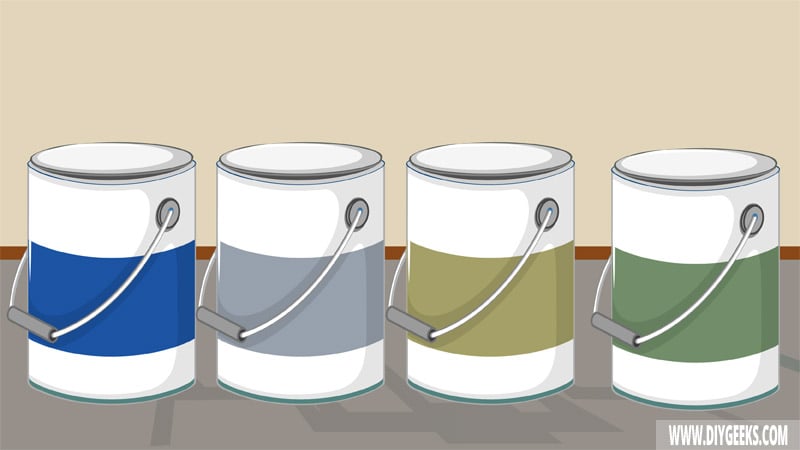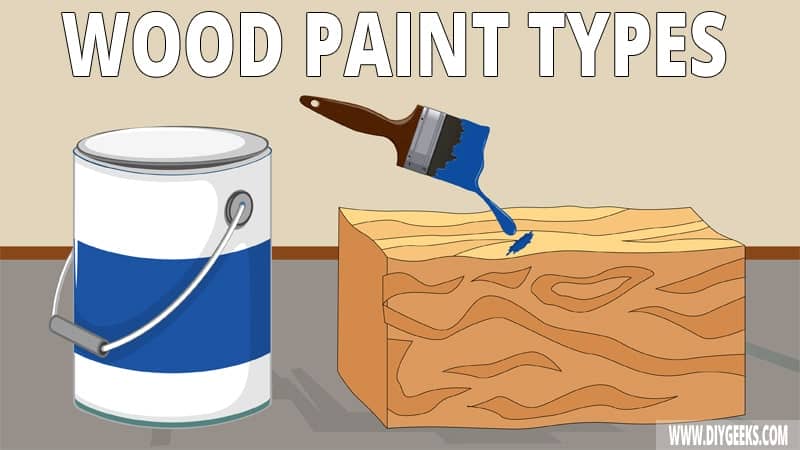Different paint types to use on wood are oil-based paint, water-based paint, varnish, and acrylic paint.
Paint doesn’t damage wood if you use the right paint type and application methods. A few paint coats will create a colorful finish and protect the surface from small water or moisture amounts.
Does Paint Damage Wood?
Paint doesn’t damage wood if you use the right paint type and application methods. Wood is a porous material that absorbs liquid into its pores, while paint is a liquid that penetrates the wood pores to adhere, so they are compatible.
A few paint coats give the wood a colorful finish and protect it from small water or moisture amounts.
However, you can’t use all paint types over wooden surfaces. For instance, Rust-Oleum spray paint is designed for metal surfaces and has extra additives that can damage or discolor the wooden surface.
Different Paint Types For Wooden Surfaces

Different paint types for wooden surfaces are listed below.
- Oil-based paints.
- Water-based paints.
- Varnish.
- Acrylic paints.
Oil-Based Paints
Oil-based paint is a paint type that uses synthetic or natural oil as its main solvent or carrier. It creates a glossy moisture-resistant finish that reflects light and protects the wood from small water amounts.
Oil-based paints have a longer dry time as their solvent (oil) takes longer to evaporate from the coating than water. It has a thick viscosity, durable finish, and good surface adhesion.
Pros:
- Lasts long on wood.
- Offers good coverage with fewer coats.
- It’s water-resistant.
- Offers good wood protection.
- Has a glossy and smooth finish.
Cons:
- Long dry time.
- Tends to yellow after a few months.
- It’s hard to apply over it.
Water-Based Paints
Water-based paints are paint types that use water as their main solvent or carrier. It creates a dull and textured finish that covers the surface imperfections but doesn’t reflect light.
Water-based paint formula consists of pigments (or colorants), binders, solvents (water), and other additives. The simple formula gives water-based paint a faster dry time but lower durability when compared to other paint types.
You can choose several types: latex, chalk, milk, and eggshell paint. All of these water-based paints have a thin flow and are easy to apply on wood.
Pros:
- Easy To Apply
- It can be mixed with other paints.
- Colorful finish.
- Fast dry time.
- Cheap.
Cons:
- Not durable.
- It can be damaged easily.
- Not waterproof or water-resistant.
- Water-soluble.
- Not weather-friendly.
- You can’t apply it over exterior surfaces.
Varnish
Varnish is a protective coating that creates a moisture-resistant layer (or barrier) over wooden surfaces and protects them from moisture, water, scratches, and weather elements.
There are different varnish types and each has a different feature or quality, but all types create a protective layer over the surface. For instance, acrylic varnish is a colorful protective finish.
Varnish is a topical finish and doesn’t need to penetrate a surface to adhere, it stays over the wood top layer where it creates its protective barrier.
Pros:
- Waterproof or water-resistant (depending on the type).
- Clear finish.
- You can apply it over paint.
- You can tint it with any water-based paint.
- Withstands wear and tear.
- Protect wood.
- Easy to clean and maintain.
Cons:
- Long Dry Time.
- Hard to Apply.
Acrylic Paints
Acrylic paint is a water-based paint known for its high pigment amount, good surface adhesion qualities, fast dry time, and colorful finish.
Over 60% of acrylic paint formula contains pigments (or colorants). The paint is used for decorative surfaces or artwork. Its formula creates a colorful finish that isn’t durable or resistant to high water amounts.
You can mix acrylic paint with any paint or sealer type to get a colorful and durable finish.
Pros:
- Colorful and bright finish.
- Good surface adhesion.
- Cheap.
- Fast dry time.
Cons:
- Weak durability or protection levels.
- Poor surface coverage.
- It’s not water-resistant.
- You can’t apply it over exterior surfaces.
What Paint Type To Use For Different Wood Types?
Furniture
Use semi-gloss latex paint over interior furniture surfaces as interior surfaces aren’t exposed to constant water or usage and don’t need a protective finish.
Seal the paint finish with polyurethane or varnish if the interior furniture is exposed to constant water or usage. Unsealed latex paint can’t withstand high water exposure.
Trim
Use semi-gloss enamel paint over wood trims as the paint prevents dust and debris from accumulation and protects the surface from wear and tear.
Wooden trims are installed in high-traffic rooms, but they aren’t exposed to constant touching or water so they don’t need much protection.
Doors
Use latex paint for interior wooden door surfaces as the paint creates a colorful finish that lasts long. Door surfaces aren’t exposed to water so they don’t need a protective finish.
Use exterior enamel paint for exterior door surfaces as they are exposed to constant water, handling, and weather elements. Exterior enamel paint sealed with spar varnish (or polyurethane) will create a colorful and durable finish that can protect exterior door surfaces for a few years.
Floors
Use high-gloss latex paint for interior wooden floors and seal the paint finish with polyurethane. Interior wooden floors are exposed to high foot traffic and need a protective sealer to protect them.
Table
Use water-based paint for interior table surfaces.
Fence
Use exterior enamel paint and polyurethane for wood fences as they are exposed to weather elements, water, moisture, and dust.
Cabinets
Use semi-gloss latex paint for wooden cabinets as the surface isn’t exposed to constant water or handling.
Bare Wood
Use water-based paint for interior bare wooden surfaces, and oil-based paint with a sealer for exterior bare wooden surfaces.
Pressure Treated Wood
Use exterior varnish over pressure-treated wooden surfaces.
Things to Know Before Painting Wood
- Always clean the surface before painting.
- Remove the existing finish.
- Sand the surface with medium-grit sandpaper.
- Always follow the manufacturer’s instructions.
- Allow each coat of paint to dry before applying the next one.
- Use the right type of paint for wood.
- Use a wood sealer, such as polyurethane or varnish, for outdoor surfaces.
- Paint in the direction of the wood grain, not against it.


